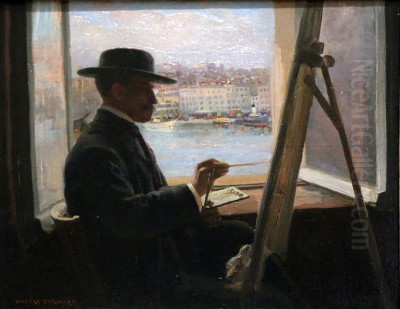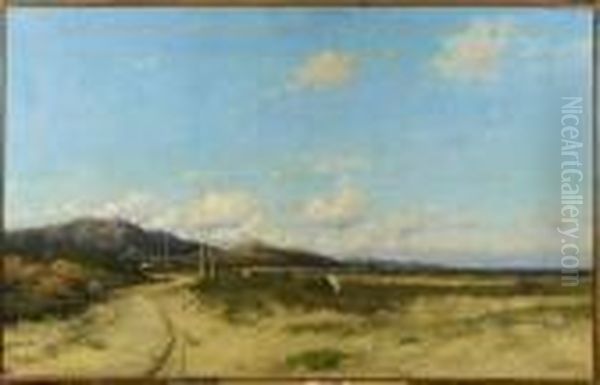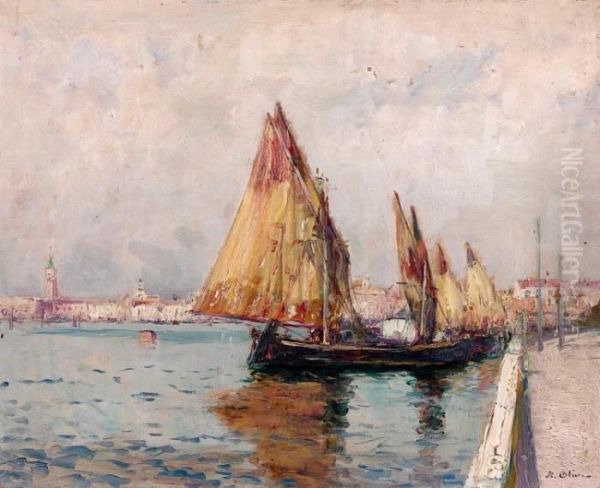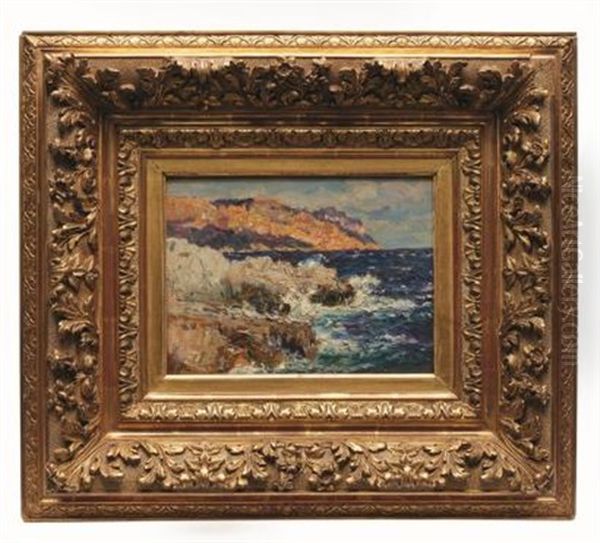
Jean-Baptiste Olive (1848-1936) stands as a significant figure in French art history, particularly renowned for his evocative depictions of the Mediterranean coast. A prominent member of the Marseille School, Olive dedicated his long career to capturing the unique light, vibrant colours, and dynamic atmosphere of Provence and its surrounding waters. His work forms a fascinating bridge between the academic traditions of the 19th century and the burgeoning modernism of the early 20th century, leaving behind a legacy of luminous landscapes and seascapes that continue to captivate viewers today. Born and trained in Marseille, his artistic journey took him frequently to Paris, where he gained recognition in the prestigious Salons and contributed to major decorative projects, solidifying his reputation both regionally and nationally.
Early Life and Artistic Formation in Marseille
Jean-Baptiste Olive was born in Marseille in 1848 into the family of a wine merchant. His early life unfolded in this bustling Mediterranean port city, an environment that would profoundly shape his artistic vision. Showing artistic promise, he pursued formal training at the École des Beaux-Arts in Marseille. There, he honed his foundational skills under the tutelage of Joanny Rave. Under Rave's guidance, Olive initially focused on still life painting, mastering the precise rendering of objects and textures, a skill that would underpin the detailed observation evident even in his later landscape work.
Another significant early influence was the painter Antoine Vollon, known for his rich still lifes and landscapes. Although primarily based in Paris, Vollon's impact, perhaps through reputation or shared circles, likely encouraged Olive's appreciation for realist techniques and the expressive potential of paint application. Olive's education in Marseille provided him with a solid grounding in academic principles, emphasizing drawing, composition, and the traditional handling of paint. This formal training instilled a sense of structure and discipline that remained visible throughout his career, even as he embraced more modern stylistic elements. His formative years were spent absorbing the sights, sounds, and unique light of his native Provence.
The Evolution of a Luminous Style

While Olive began with still life, his true passion emerged in landscape and marine painting. He transitioned towards capturing the outdoor world, particularly the dramatic coastline and sun-drenched vistas of the Midi. His style evolved significantly, moving beyond strict academic realism to incorporate elements inspired by the Impressionist movement, which was revolutionizing French art during his formative years. He became particularly adept at rendering the effects of light, especially the brilliant, often intense, sunlight of the Mediterranean.
Olive developed a remarkable ability to convey the shimmering quality of light on water, the warmth of the sun on stone, and the subtle shifts in atmospheric conditions. While not strictly an Impressionist painter who dissolved form completely into light and colour, he adopted their brighter palette and often employed looser, more visible brushstrokes to capture fleeting moments and the vibrancy of the scene. His works often balance detailed observation, particularly in the rendering of boats or architectural elements, with a more suggestive handling of sea and sky.
Later in his career, hints of Post-Impressionist sensibilities emerged. Some works show a tendency towards simplified forms and the use of bolder, more distinct areas of colour. There is evidence suggesting that in his later practice, he sometimes applied paint directly from the tube onto the canvas, perhaps foregoing traditional underpainting techniques to achieve greater immediacy and chromatic intensity. This blend of realism, Impressionist light effects, and subtle modern touches created Olive's distinctive and highly personal style.
The Mediterranean Muse: Provence and the Sea
The Mediterranean Sea and the landscapes of Provence were the undeniable heart of Jean-Baptiste Olive's artistic output. He possessed an intimate understanding of the region, born from a lifetime of observation. His canvases are filled with the iconic scenery of the French Riviera, the Calanques near Marseille, the bustling activity of the Old Port, and quieter coastal stretches along the shores of Provence and even Corsica. He was particularly drawn to the interplay between land, sea, and sky.
Olive excelled at capturing the sea in its various moods – from calm, reflective surfaces mirroring the azure sky, to choppy waters whipped by the Mistral wind. His paintings often feature the characteristic red rocks of the Esterel, the rugged cliffs plunging into turquoise waters, and the distinctive silhouettes of pine trees against the bright horizon. He painted Marseille's harbour repeatedly, documenting its maritime life, the forest of masts, and the surrounding architecture like the La Major Cathedral and the Fort Saint-Jean.

His dedication to this region went beyond mere topographical representation. Olive sought to convey the feeling of the Mediterranean – its warmth, its brilliance, its timeless allure. He often favoured painting during the afternoon, capturing the strong, clear light that defines the South of France. Works like La plage de Saint Florent, en Corse (The Beach of Saint Florent, Corsica) or views of Cassis and the Joliette ports in Marseille exemplify his commitment to his primary subject matter. His paintings serve as luminous love letters to his native Provence.
Career Success and Recognition
Jean-Baptiste Olive achieved considerable success during his lifetime. His official debut came in 1874 when he first exhibited at the prestigious Paris Salon, the primary venue for artists seeking recognition. This marked the beginning of a long and consistent presence in the Parisian art world, even as he maintained strong ties to Marseille. He became a regular exhibitor at the Salon des Artistes Français.
His talent did not go unnoticed. In 1886, he received a medal at the Salon, specifically acknowledging his skill in depicting sun-drenched landscapes, a testament to his mastery of light. Further accolades followed, including a silver medal for his contribution to the decorative arts at the Exposition Universelle (World's Fair) held in Paris in 1889. He continued to exhibit widely, including participation in the "Galeries des Artistes" shows in 1893 and 1899.
Beyond easel painting, Olive undertook significant decorative commissions. He contributed murals and decorative panels to several prominent Parisian locations, including the Cirque d'Hiver, the Basilica of Sacré-Cœur in Montmartre, and various pavilions for World's Fairs. Perhaps most famously, he created large-scale paintings depicting Mediterranean scenes for the opulent "Le Train Bleu" restaurant within the Gare de Lyon railway station in Paris, works that can still be admired today. In 1930, his contributions were further recognized when he was awarded the Léon Bonnat Prize.
Artistic Network: Teachers, Peers, and Patrons
Like most artists, Jean-Baptiste Olive operated within a network of relationships that included teachers, fellow artists, and supporters. His primary teacher at the École des Beaux-Arts in Marseille was Joanny Rave, who provided his initial formal training. The influence of Antoine Vollon, a master of realism, also shaped his early development, particularly in still life.
In the course of his career, Olive associated with numerous other artists, particularly those connected to the Provençal or Marseille schools. He maintained good relationships and exhibited alongside painters such as Étienne Cornellier, Gustave Marius Jullien, Antoine Vallon (likely a different artist than his teacher influence), Robert Mols, Raymond Allègre, and Théodore Déphi. These connections fostered a supportive environment and facilitated participation in group exhibitions and artistic circles both in Marseille and Paris.

His contemporaries within the broader Provençal tradition included figures like Paul Guigou and Adolphe Monticelli, artists who also sought to capture the unique character of the region, albeit with different stylistic approaches. Olive's success was also aided by patrons who recognized and supported his talent. Notable among these were General Malesherbes and Marie-Louis Gassier, individuals who likely provided crucial encouragement or financial assistance, particularly in the earlier stages of his career. While specific details of direct competition are scarce, Olive naturally vied for attention and sales alongside countless other artists exhibiting at the Salons and galleries.
Representative Works and Their Characteristics
Jean-Baptiste Olive's extensive body of work primarily consists of landscapes and seascapes. Several paintings stand out as representative of his style and preferred subjects:
La plage de Saint Florent, en Corse (1885): A large canvas (128 x 200 cm) exhibited at the 1885 Salon, showcasing his ability to handle expansive coastal scenes and capture the specific light of Corsica.
Venise (Venice, late 19th Century): Measuring 50.3 x 73.5 cm, this work demonstrates Olive's occasional foray beyond Provence, applying his sensitivity to light and water to the iconic Italian city.
Marseille et les mers agitées (Rough Seas around Marseille): A smaller work (25.5 x 32.4 cm) capturing the dynamic energy of the sea, likely depicting the turbulent conditions brought by the Mistral wind near his home city.
La Major et les ports de la Joliette (La Major Cathedral and the Joliette Ports): This painting (46 x 65 cm) is a classic Marseille view, combining architectural elements with the bustling activity of the port, rendered with his characteristic attention to light and atmosphere.
Le cap canaille à Cassis: Views of the dramatic cliffs at Cap Canaille near Cassis were a recurring theme, allowing Olive to explore the interplay of rock, sea, and intense sunlight.
Bateaux Quai de la Rive Neuve, Marseille: Depictions of boats moored along the quays of Marseille's Old Port are common, showcasing his skill in rendering maritime details within a broader atmospheric context.
These works, varying in size and specific location, consistently display Olive's fascination with the Mediterranean environment, his skillful handling of light and colour, and his ability to balance detailed observation with evocative atmosphere.
Art Historical Significance and Position
Jean-Baptiste Olive occupies a distinct and respected position within French art history. He is firmly established as one of the leading figures of the Marseille School of painting, alongside artists like Paul Guigou and Adolphe Monticelli. His work epitomizes the late 19th and early 20th-century Provençal landscape tradition, focusing on the accurate yet poetic rendering of local scenery.
His artistic style places him interestingly at a crossroads. Rooted in the realist and academic training of his youth, he embraced the innovations of Impressionism, particularly its emphasis on capturing light and atmosphere through colour and brushwork. Yet, he rarely dissolved form to the extent of core Impressionists like Claude Monet or Camille Pissarro. Furthermore, elements in his later work hint at an awareness of Post-Impressionist concerns with structure and colour, though he never fully adopted the more radical styles of artists like Van Gogh or Cézanne (who also famously painted Provence).
Consequently, Olive can be seen as a transitional figure, skillfully blending tradition with modernity. He successfully adapted contemporary techniques to his own vision without abandoning the solid draftsmanship and compositional structure learned in his academic training. He represents a significant strain of French landscape painting that continued to find value in representation while absorbing the lessons of Impressionism regarding light and colour. His primary contribution lies in his masterful and prolific depiction of the Mediterranean coast, solidifying his place as a key interpreter of the Provençal landscape.
Legacy, Collections, and Market Presence
Jean-Baptiste Olive's legacy endures primarily through his paintings, which continue to be appreciated for their beauty and technical skill. His works are held in various public and private collections, particularly in France. The Musée Cantini in Marseille, fittingly, holds a significant collection and honoured him with a large retrospective exhibition of 82 works during his lifetime, in 1930, cementing his status as a major local figure. While perhaps less internationally famous than the leading Impressionists, his paintings are represented in other French museums and appear regularly on the art market.
His works frequently feature in auctions, handled by major houses like Christie's and Phillips, as well as numerous French auctioneers. Auction records show a consistent demand for his paintings. Prices vary depending on size, subject matter, condition, and period, ranging from a few thousand euros for smaller studies or less typical subjects, to tens of thousands of euros for prime examples of his Marseille or Cassis views. For instance, recent sales have seen works like La côte près de Marseille fetch around €4,000-€5,000, while more significant pieces like Bateaux Quai de la Rive Neuve, Marseille were estimated at €12,000-€15,000. This indicates a stable market appreciation for his art, especially among collectors interested in French landscape painting and the Marseille School.
Academically, Olive's work has been documented and studied. He is included in scholarly assessments of Provençal art, and his works feature in catalogues raisonnés and monographs dedicated to the region's painters, such as Franck Baille's Regard de Provence and a dedicated monograph by Gamet. While perhaps not the subject of constant groundbreaking research, his place within the narrative of late 19th and early 20th-century French art is secure.
Conclusion: An Enduring Vision of the South
Jean-Baptiste Olive devoted his artistic life to capturing the essence of the Mediterranean, particularly the coast of his native Provence. As a leading member of the Marseille School, he developed a distinctive style that skillfully blended academic foundations with the light-filled palette and atmospheric concerns of Impressionism, occasionally touching upon Post-Impressionist sensibilities. His mastery lay in his ability to render the unique quality of Mediterranean light, the vibrant colours of the sea and landscape, and the specific character of locations from Marseille's bustling port to the rugged Calanques and the shores of Corsica.
Through countless canvases, decorative commissions for prestigious venues, and consistent recognition at the Paris Salons, Olive built a successful career and left a significant mark on French art. While his name may not carry the global resonance of some contemporaries, his work remains highly esteemed, particularly within France, for its technical proficiency, its evocative beauty, and its authentic portrayal of the South. Jean-Baptiste Olive remains a key figure for understanding the evolution of landscape painting in France at the turn of the century and stands as one of the most accomplished painters of the Mediterranean world. His luminous visions continue to transport viewers to the sunlit shores of Provence.